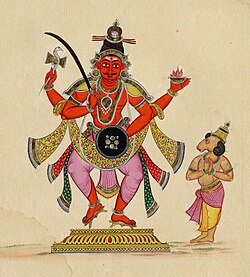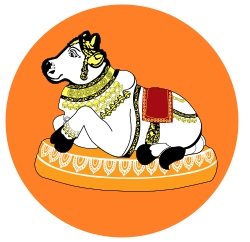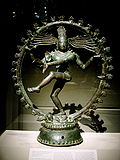Virabhadra
| Virabhadra | |
|---|---|
 Virabhadra and Daksha | |
| Other names |
|
| Affiliation | Shiva |
| Abode | Mount Kailash |
| Planet | Angaraka (Mars) |
| Mantra |
|
| Weapon | Trident, sword, arrow, discus, conch, spear, staff, thunderbolt, two varieties of shields, bow, noose, goad, axe, and club. |
| Day | Tuesday |
| Mount | |
| Texts | Shiva Purana |
| Festivals | |
| Consort | Bhadrakali |
| Part of a series on |
| Shaivism |
|---|
 |
| |
Virabhadra (Sanskrit: वीरभद्र, romanized: Vīrabhadra, lit. 'auspicious hero'),[1] also rendered Veerabhadra, Veerabathira, and Veerabathiran, is a fierce form of the Hindu god Shiva.[2] He is created by the wrath of Shiva, when the deity hurls a lock of his matted hair upon the ground, upon hearing of the self-immolation of his consort, Sati, at the Daksha yajna.[3][4][5]
He appears in the Puranas as a vengeful being, attacking the deities who had attended the Daksha yajna with Bhadrakali. In the ensuing melee, Bhaga's eyes are plucked out,[6] Agni, Mitra, and Chandra are also accosted.[7] The fate of Daksha himself varies from text to text: Virabhadra either decapitates him,[8] urges him to beg forgiveness from Shiva,[9] or is saved by Vishnu, who defeats Virabhadra.[10][11]
Legend
[edit]Origin
[edit]
Notes
Virabhadra was created by Shiva after Sati, Shiva's wife, immolated herself during the Daksha Yajña.
The origin of the Daksha Yajña legend lies in Taittirīya Samhita 2.6.8, where Rudra (later Shiva) was excluded from the sacrifice by the Devas, then Rudra pierced the sacrifice. Pushan lost his teeth and Bhaga got blinded. This legend is also mentioned in the Shatapatha Brāhmana of the Shukla Yajurveda and in the Gopatha Brāhmana of the Atharvaveda. The Gopatha Brāhmana version mentions Prajapati as the one who excluded Rudra from the sacrifice. In post-Vedic literature, Daksha Prajapati excluded Shiva from the Yajña.
According to Shaivism, Virabhadra's origins are described as follows: Sati was the youngest daughter of Daksha. While growing up, she had her heart set on Shiva and worshipped him. During the svayamvara of Sati, Daksha invited all the Devas and princes except Shiva. Sati cast her garland into the air, calling upon Shiva to receive it, and beheld him to be standing in the midst of the court, with the garland about his neck. Daksha had no choice but to accept the marriage of his daughter to Shiva.[12]
One day, Daksha invited all the deities, as well as all of his children and grandchildren, in order to perform a ritual sacrifice, deliberately not inviting Sati and Shiva. Sati's urge to attend the event, due to her affection towards her parents, overpowered the social etiquette of not going to an uninvited ceremony. When Shiva refused to accompany her, Sati insisted on attending the ritual without him. Upon her arrival, Daksha started to humiliate her and her husband, expressing his hatred for Shiva in front of the entire assembly of people. Unable to bear the ignominy, the furious Sati leapt into the sacrificial fire, immolating herself with her yogic abilities. When Shiva heard of these tidings, he tore a clump of his matted hair, from which Virabhadra and Bhadrakali emerged.[13] Shiva instructed Virabhadra to lay waste to the sacrifice, and destroy all of its participants.[14] Veerabhadra is a small element of Shiva. Shiva himself personally did not want to get into a violent mode. So, he took a strand of his hair and created Veerabhadra.
The Padma Purana identifies Virabhadra as the fierce form of Mangala (Mars). Virabhadra is born when Shiva, due to his anguish regarding the death of Sati, perspires, and his perspiration falls upon the earth. This gives birth to the fierce Virabhadra, who destroys the sacrifice. In the aftermath, Shiva calms him down and makes him Angaraka, the planet Mars.[15]
Daksha yajna
[edit]The Skanda Purana states that ill-omens immediately started to surface when Shiva's forces started to march upon the Daksha yajna, describing a rain of blood and meteor showers. Finding these phenomena to be foreboding, Daksha sought the protection of Vishnu, who agreed to offer it, while also according blame to the former for his disrespect. The forces consisted of the Navadurga, rakshasas, yakshas, pishachas, a host of bhutas, thousands of ganas, as well as yoginis and guhyakas. These forces were commanded by the three-eyed Virabhadra, bearing a thousand arms, entwined with great serpents, with his chariot drawn by two thousand horses and a million lions. Indra and the devas were assisted by Bhrigu in routing the first wave of gana attacks. Angered, Virabhadra marshalled his forces in a counterattack, and wielding their battle-axes and iron clubs, they started to massacre the devas. The sages begged Vishnu to defend the sacrifice from the attackers, and the deity prepared to fight against Virabhadra. While Virabhadra offered his obeisance to the preserver deity, he accused him of seeking a share of the offerings of the sacrifice, and warned him against staying there. Vishnu laughed, and informed him that he had a duty to shield his devotees, and would leave after he had had his fill of Virabhadra's missiles. Indra chose to challenge Virabhadra, and struck him with his vajra. In retaliation, Virabhadra attempted to swallow Indra as well as his mount, Airavata. Vishnu intervened, saving Indra, and obstructing the assault of Virabhadra. He also summoned the Ashvins, who healed the fallen devas with their medicine. Enraged, Virabhadra confronted Vishnu. The preserver deity employed his Sudarshana Chakra against Virabhadra, which the latter swallowed whole. After retrieving his celestial discus, satisfied that he had turned the tide of the battle, Vishnu returned to his abode.[16] Not satisfied with the carnage, Virabhadra accosted Bhrigu, Pushan, and when he saw the terrified Daksha cowering beneath the altar, he beheaded him, offering his head to the fire as a sacrifice. The disturbed Brahma visited Shiva, and begged him to put an end to the bloodshed. Shiva arrived at the Daksha yajna, conversed with Virabhadra, and restored life to Daksha by placing the head of a deformed animal upon his neck. The resurrected Daksha offered his obeisance to Shiva, which ended the conflict.[17]
Various scriptures, coloured by their traditions, offer variations of the conflict, and Virabhadra's role in the legend. The Kurma Purana has Virabhadra realise that Vishnu and Shiva are the same deity, and proclaim that the world was created by Narayana. In the Harivamsha and Vamana Purana, Vishnu gains the upper hand in his fight against Virabhadra.[18][19]
Significance
[edit]Veerbhadra is considered gotrapurusha / forefather of many jat clans and VeeraShaiva-lingayat subsects(like lingayat vani).They believe to be originated from Shiva's Jats and therefore worship lord virabhadra as their ancestral god. They believe in having qualities of a Kshatriya and neglect discrimination and ego (same was the purpose of virabhadra to kill daksha).[20][21][22][23]
Many temples were created by rulers of veerashiva lingayat faith including the lepakshi veerbhadra temple.The temple was built in 1530 CE (1540 CE is also mentioned) by Virupanna Nayaka and Viranna, both brothers who were Governors under the Vijayanagar Empire.According to Skanda Purana, the temple is one of the divyakshetras, an important pilgrimage site of Lord Shiva.[24]
Gallery
[edit]References
[edit]- ^ www.wisdomlib.org (29 June 2012). "Virabhadra, Vira-bhadra, Vīrabhadra: 24 definitions". www.wisdomlib.org. Retrieved 29 November 2022.
- ^ Wangu, Madhu Bazaz (2003). Images of Indian Goddesses: Myths, Meanings, and Models. Abhinav Publications. p. 41. ISBN 978-81-7017-416-5.
- ^ the Horse-sacrifice of the Prajapati Daksha The Mahabharata translated by Kisari Mohan Ganguli (1883–1896), Book 12: Santi Parva: Mokshadharma Parva: Section CCLXXXIV. p. 315 Mahadeva created from his mouth a terrible Being whose very sight could make one's hair stand on its end. The blazing flames that emanated from his body rendered him exceedingly awful to behold. His arms were many in number and in each was a weapon that struck the beholder with fear. p. 317. “I am known by the name of Virabhadra’’ and I have sprung from the wrath of Rudra. This lady (who is my companion), and who is called Bhadrakali, hath sprung from the wrath of the goddess.”
- ^ Vishnu Purana SACRIFICE OF DAKSHA (From the Vayu Purana.) The Vishnu Purana, translated by Horace Hayman Wilson, 1840. p. 62, "In former times, Daksha commenced a holy sacrifice on the side of Himaván, at the sacred spot Gangadwara, frequented by the Rishis. The gods, desirous of assisting at this solemn rite, came, with Indra at their head, to Mahadeva, and intimated their purpose; and having received his permission, departed in their splendid chariots to Gangadwára, as tradition reports.” 62:2 The Linga Purana is more precise, calling it Kanakhala, which is the village still called Kankhal, near Haridwar.p. 66 Rudrakali. p. 68 Vírabhadra said, 'I am not a god, nor an Aditya; nor am I come hither for enjoyment, nor curious to behold the chiefs of the divinities: know that I am come to destroy the sacrifice of Daksha, and that I am called Vírabhadra, the issue of the wrath of Rudra. Bhadrakali also, who has sprung from the anger of Devi, is sent here by the god of gods to destroy this rite. Take refuge, king of kings, with him who is the lord of Uma; for better is the anger of Rudra than the blessings of other gods.'
- ^ "The story of Veerbhadra". Sadhguru Wisdom. Retrieved 7 September 2024.
- ^ Williams, George M. (27 March 2008). Handbook of Hindu Mythology. OUP USA. p. 78. ISBN 978-0-19-533261-2.
- ^ Coulter, Charles Russell; Turner, Patricia (4 July 2013). Encyclopedia of Ancient Deities. Routledge. p. 853. ISBN 978-1-135-96397-2.
- ^ Tapasyananda, Swami. Srimad Bhagavata – Volume 1. Sri Ramakrishna Math(vedantaebooks.org). p. 43.
- ^ Valmiki; Vyasa (19 May 2018). Delphi Collected Sanskrit Epics (Illustrated). Delphi Classics. p. 7301. ISBN 978-1-78656-128-2.
- ^ Books, Kausiki (24 October 2021). Siva Purana: Rudra Samhitha: 2 Sati Khanda: English Translation only without Slokas. Kausiki Books. p. 42.
- ^ Oriental Translation Fund. 1840. p. 68.
- ^ Sister Nivedita & Ananda K. Coomaraswamy: Myths and Legends of the Hindus and Buddhists, Kolkata, 2001 ISBN 81-7505-197-3
- ^ Dalal, Roshen (18 April 2014). The Religions of India: A Concise Guide to Nine Major Faiths. Penguin UK. p. 371. ISBN 978-81-8475-396-7.
- ^ Doniger, Wendy (March 2014). On Hinduism. OUP USA. p. 226. ISBN 978-0-19-936007-9.
- ^ Padma Purana Srishti Khanda First Canto Chapter 24.Verse 29b-41a. English translation by Motilal Bansaridas Publications Book 1 page 343-344 Link: https://archive.org/details/PadmaPuranaVol05BhumiAndPatalaKhandaPages15651937ENGMotilalBanarsidass1990_201901
- ^ www.wisdomlib.org (14 December 2019). "A Fight between Vīrabhadra and Viṣṇu and Others [Chapter 4]". www.wisdomlib.org. Retrieved 29 November 2022.
- ^ Bhatt, G. P.; Shastri, J. L.; Deshpande, N. A. (1992). The Skanda Purana Part 1: Ancient Indian Tradition And Mythology Volume 49. Motilal Banarsidass. pp. 15–30. ISBN 978-81-208-0966-6.
- ^ Sharma, Arvind (2007). Essays on the Mahābhārata. Motilal Banarsidass Publishers. p. 126. ISBN 978-81-208-2738-7.
- ^ Vamana Purana English Translation with Sanskrit Text. pp. 16–17.
- ^ Parāñjape, Tārābāī (1985). Sīmā pradeśātīla bhāvagaṅgā (in Marathi). Marāṭhī Sāhitya Parishada, Āndhra Pradeśa.
- ^ Y.P.Shastri, op.cit., p.40-41
- ^ Dr Ram Swarup Joon, History of the Jats (Eng), 1967, p.14-15
- ^ Thakur Deshraj: Jat Itihas, 1934, p. 85-86
- ^ Knapp, Stephen (2009). Spiritual India handbook: a guide to temples, holy sites festivals and traditions. Mumbai: Jaico Publ. House. ISBN 978-81-8495-024-3.


 French
French Deutsch
Deutsch



